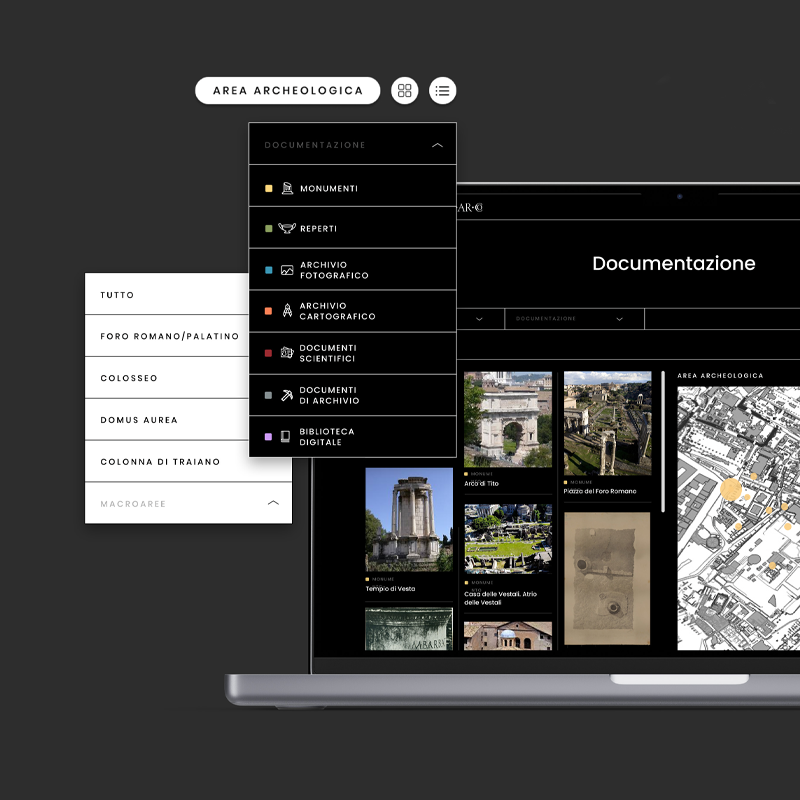Multimedia production “Dalla Matita al Pixel”
“Revisiting the Roman Forum: From Pencil to Pixel” at the Curia of the Roman Forum is a place of encounter between technological language and the memory of the past. The Soprintendenza Speciale di Roma commissioned this exhibition to showcase the processes of archaeological documentation and its evolution from 1905 to 2014.
Visivalab has played a fundamental role in the digitization of the Soprintendenza’s Archive and in various digital scanning campaigns in the Roman Forum. Our extensive experience and documental database has allowed us to create multimedia content that enriches this exhibition, for which we have produced five videos. In these videos, the monuments are rediscovered by comparing historical archaeological documentation techniques with modern ones.
CLIENT Soprintendenza Speciale per i Beni Archeologici di Roma and Electa Mondadori
YEAR 2014
FEATURES
- Informative video
- High-quality digitalization of documentary heritage
- Laser scanning of monuments
- Creation of video storytelling and storyboard
- Editing and post-production of audiovisual images
- 3D models
- Animation of historical illustrations and engravings
- Divulging of archaeological practices
Project
Our audiovisual production is divided into five thematic areas each focused on a monument. The videos establish meaningful connections between the archaeological practices of the past and innovative technologies, while enhancing the processes of digitalization and post-production of historical documentation. The high-resolution images allow a more detailed appreciation of the monuments, paying tribute to Giacomo Boni’s meticulous research.
Below, you can view the videos along with a brief description:
COMITIUM: TODAY AND YESTERDAY EXCAVATIONS
The video starts with a simulation of the captive balloon ascent over the Lapis Niger area, based on an old orthophotography that then merges seamlessly with Guido Cirilli’s plan. Thanks to the high-quality digitalization, we can observe details imperceptible to the naked eye, such as the Lapis Niger inscription, the Cloaca Maxima conducts and wells, and other elements of the excavation. The video also features a reconstruction of the Comitium’s 3D model generated through laser scanning and texturized with 4K video material, concluding with a hyper-lapse of on-site documentation images.
CLOACA MAXIMA
This video features the complex drainage and sewer system of the Cloaca Maxima. It immerses the viewer in a virtual underground journey from the Basilica Julia to the Basilica Emilia, exploring passages that are currently inaccessible. At the end of the video, it is possible to understand the confluence between cutting-edge techniques and historical documentation: the scanner identified only one block of height in the partially buried duct under Basilica Emilia, while analyzing the old drawings revealed that it was actually three.
FROM 2D TO 3D
This video offers a three-dimensional reproduction of the Lapis Niger sacred area, based on the magnificent and detailed drawing by Cirilli that we had previously digitized. The images show the reconstruction of the 3D model obtained from the point cloud, on which we applied the two-dimensional drawing as a texture. The end of the video shows the monument’s laser acquisition process, with its different parts differentiated by colors.
VIA SACRA AT BASÍLICA DI MASSENZIO
This video focuses on the Via Sacra and uses two historical drawings as a base: the area topographic survey and Via Sacra longitudinal section in relation to its sewer system and wells. It starts with the aerial orthophotography, which then perfectly blends with Boni’s drawing. Thanks to the high resolution of the digitized plans, it is possible to appreciate Boni’s meticulousness in documenting archaeological finds. In the last part of the video, historical cartography is associated with the laser scanner survey, merging the textured point cloud with the original drawing.
AXONOMETRY vs TRIDIMENSIONALITY
The last video is based on two detailed axonometric drawings of the Lapis Niger. The images are divided into different layers of information, accompanied by a gentle, blurred camera movement. This technique creates a perspective illusion, providing viewers with the sensation of being able to see beyond the depicted monuments.
The video concludes by juxtaposing the images captured by the high-definition Faro Arm scanner with the data gathered by Boni and his team. This comparative analysis allowed us to re-examine the stone, the inscription, and its state of preservation, enabling a deeper appreciation for the significance, beauty, and precision of both historical drawings and the acquired photographs.


